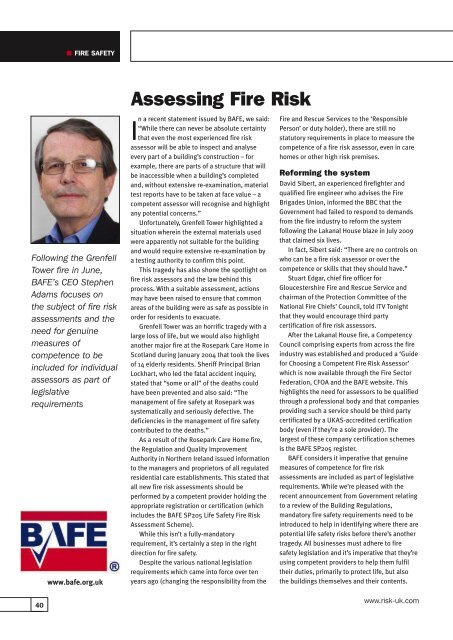PSISeptember2017
You also want an ePaper? Increase the reach of your titles
YUMPU automatically turns print PDFs into web optimized ePapers that Google loves.
FIRE SAFETY<br />
Following the Grenfell<br />
Tower fire in June,<br />
BAFE’s CEO Stephen<br />
Adams focuses on<br />
the subject of fire risk<br />
assessments and the<br />
need for genuine<br />
measures of<br />
competence to be<br />
included for individual<br />
assessors as part of<br />
legislative<br />
requirements<br />
40<br />
www.bafe.org.uk<br />
Assessing Fire Risk<br />
n a recent statement issued by BAFE, we said:<br />
I“While there can never be absolute certainty<br />
that even the most experienced fire risk<br />
assessor will be able to inspect and analyse<br />
every part of a building’s construction – for<br />
example, there are parts of a structure that will<br />
be inaccessible when a building’s completed<br />
and, without extensive re-examination, material<br />
test reports have to be taken at face value – a<br />
competent assessor will recognise and highlight<br />
any potential concerns.”<br />
Unfortunately, Grenfell Tower highlighted a<br />
situation wherein the external materials used<br />
were apparently not suitable for the building<br />
and would require extensive re-examination by<br />
a testing authority to confirm this point.<br />
This tragedy has also shone the spotlight on<br />
fire risk assessors and the law behind this<br />
process. With a suitable assessment, actions<br />
may have been raised to ensure that common<br />
areas of the building were as safe as possible in<br />
order for residents to evacuate.<br />
Grenfell Tower was an horrific tragedy with a<br />
large loss of life, but we would also highlight<br />
another major fire at the Rosepark Care Home in<br />
Scotland during January 2004 that took the lives<br />
of 14 elderly residents. Sheriff Principal Brian<br />
Lockhart, who led the fatal accident inquiry,<br />
stated that “some or all” of the deaths could<br />
have been prevented and also said: “The<br />
management of fire safety at Rosepark was<br />
systematically and seriously defective. The<br />
deficiencies in the management of fire safety<br />
contributed to the deaths.”<br />
As a result of the Rosepark Care Home fire,<br />
the Regulation and Quality Improvement<br />
Authority in Northern Ireland issued information<br />
to the managers and proprietors of all regulated<br />
residential care establishments. This stated that<br />
all new fire risk assessments should be<br />
performed by a competent provider holding the<br />
appropriate registration or certification (which<br />
includes the BAFE SP205 Life Safety Fire Risk<br />
Assessment Scheme).<br />
While this isn’t a fully-mandatory<br />
requirement, it’s certainly a step in the right<br />
direction for fire safety.<br />
Despite the various national legislation<br />
requirements which came into force over ten<br />
years ago (changing the responsibility from the<br />
Fire and Rescue Services to the ‘Responsible<br />
Person’ or duty holder), there are still no<br />
statutory requirements in place to measure the<br />
competence of a fire risk assessor, even in care<br />
homes or other high risk premises.<br />
Reforming the system<br />
David Sibert, an experienced firefighter and<br />
qualified fire engineer who advises the Fire<br />
Brigades Union, informed the BBC that the<br />
Government had failed to respond to demands<br />
from the fire industry to reform the system<br />
following the Lakanal House blaze in July 2009<br />
that claimed six lives.<br />
In fact, Sibert said: “There are no controls on<br />
who can be a fire risk assessor or over the<br />
competence or skills that they should have.”<br />
Stuart Edgar, chief fire officer for<br />
Gloucestershire Fire and Rescue Service and<br />
chairman of the Protection Committee of the<br />
National Fire Chiefs’ Council, told ITV Tonight<br />
that they would encourage third party<br />
certification of fire risk assessors.<br />
After the Lakanal House fire, a Competency<br />
Council comprising experts from across the fire<br />
industry was established and produced a ‘Guide<br />
for Choosing a Competent Fire Risk Assessor’<br />
which is now available through the Fire Sector<br />
Federation, CFOA and the BAFE website. This<br />
highlights the need for assessors to be qualified<br />
through a professional body and that companies<br />
providing such a service should be third party<br />
certificated by a UKAS-accredited certification<br />
body (even if they’re a sole provider). The<br />
largest of these company certification schemes<br />
is the BAFE SP205 register.<br />
BAFE considers it imperative that genuine<br />
measures of competence for fire risk<br />
assessments are included as part of legislative<br />
requirements. While we’re pleased with the<br />
recent announcement from Government relating<br />
to a review of the Building Regulations,<br />
mandatory fire safety requirements need to be<br />
introduced to help in identifying where there are<br />
potential life safety risks before there’s another<br />
tragedy. All businesses must adhere to fire<br />
safety legislation and it’s imperative that they’re<br />
using competent providers to help them fulfil<br />
their duties, primarily to protect life, but also<br />
the buildings themselves and their contents.<br />
www.risk-uk.com

















